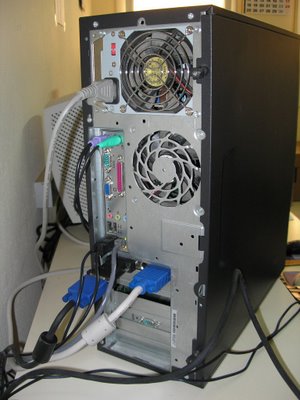(...comes from
step II)
Changes on the xorg.conf file
Since the system automatically generated a correct configuration file, this step is not really necessary. Anyway, if you need to obtain information about the bus in which your card is plugged, the
lspci command will give you such data.
Obtaining the information for the graphic card.
# lspci | grep VGA
0000:01:00.0 VGA compatible controller: nVidia Corporation NV34 [GeForce FX 5200] (rev a1)
Before making any change, it is advisable to make a backup of the original configuration file. Then edit it using your favorite text editor.
# cp /etc/X11/xorg.conf /etc/X11/xorg.conf.bak
# vi /etc/X11/xorg.conf
The next step is the edition of the xorg.conf according to your configuration. In particular, we must create the corresponding device, monitor and screen sections for every seats.
Section "Files"
FontPath "/usr/share/X11/fonts/misc"
# FontPath "/usr/share/X11/fonts/cyrillic"
FontPath "/usr/share/X11/fonts/100dpi/:unscaled"
FontPath "/usr/share/X11/fonts/75dpi/:unscaled"
FontPath "/usr/share/X11/fonts/Type1"
FontPath "/usr/share/X11/fonts/100dpi"
FontPath "/usr/share/X11/fonts/75dpi"
# path to defoma fonts
FontPath "/var/lib/defoma/x-ttcidfont-conf.d/dirs/TrueType"
EndSection
Section "Module"
Load "bitmap"
Load "ddc"
# Load "dri"
Load "extmod"
Load "freetype"
Load "glx"
Load "int10"
Load "type1"
Load "vbe"
EndSection
# ------------------------------------------------------------------------
# Input devices
# ------------------------------------------------------------------------
Section "InputDevice"
Identifier "Keyboard-base"
Driver "kbd"
EndSection
Section "InputDevice"
Identifier "Mouse-base"
Driver "mouse"
Option "Device" "/dev/input/mice"
EndSection
# ------------------------------------------------------------------------
# Dual head system. Notice the two devices sharing the same BusID
# ------------------------------------------------------------------------
Section "Device"
Identifier "Card0.0" # CRT-0 (VGA output)
Driver "nvidia"
VendorName "nVidia Corporation"
BoardName "NV34 [GeForce FX 5200]"
BusID "PCI:1:0:0"
Screen 0
Option "NoLogo"
EndSection
Section "Device"
Identifier "Card0.1" # CRT-1 (Analog-DVI, DFP-0 : Digital-DVI)
Driver "nvidia"
VendorName "nVidia Corporation"
BoardName "NV34 [GeForce FX 5200]"
BusID "PCI:1:0:0"
Screen 1
Option NoLogo"
EndSection
# ------------------------------------------------------------------------
# Monitor section: Most of the parameters are optional
# ------------------------------------------------------------------------
Section "Monitor"
Identifier "Monitor0"
VendorName "HP"
ModelName "HP D8904"
Option "DPMS"
HorizSync 30-70
VertRefresh 50-160
DisplaySize 320 240 # CRT 17" (81 DPI @ 1024x768)
EndSection
Section "Monitor"
Identifier "Monitor1"
VendorName "Compaq"
ModelName "Compaq 5500"
HorizSync 30-54
VertRefresh 50-120
DisplaySize 280 210 # CRT 15" (72 DPI @ 800x600)
Option "DPMS"
EndSection
# ------------------------------------------------------------------------
# Screen section: Pairing video cards and monitors
# ------------------------------------------------------------------------
Section "Screen"
Identifier "Screen0"
Device "Card0.0"
Monitor "Monitor0"
SubSection "Display"
Depth 24
Modes "1024x768" "800x600" "640x480"
EndSubSection
EndSection
Section "Screen"
Identifier "Screen1"
Device "Card0.1"
Monitor "Monitor1"
SubSection "Display"
Depth 24
Modes "800x600" "640x480"
EndSubSection
EndSection
# ------------------------------------------------------------------------
# Layout section
# ------------------------------------------------------------------------
Section "ServerLayout"
Identifier "Multihead"
Screen 0 "Screen0" 0 0
Screen 1 "Screen1" LeftOf "Screen0"
InputDevice "Keyboard-base" "CoreKeyboard"
InputDevice "Mouse-base" "CorePointer"
EndSection
# ------------------------------------------------------------------------
# Additional sections
# ------------------------------------------------------------------------
# Xephyr can not use DRI, so it is not enabled
# Section "DRI"
# Mode 0666
# EndSection
Section "ServerFlags"
# Xinerama does not affect this configuration, so it is not enabled
# Option "Xinerama" "on"
# Even if mouse detection fails, X will start
Option "AllowMouseOpenFail" "yes"
# VT switching is disabled
Option "DontVTSwitch" "yes"
# X restart (Ctrl+Alt+Backspace) is disabled
Option "DontZap" "yes"
EndSection

If everything was OK, when you log into your computer, you should have either two independent adjacent desktops (Xinerama disabled) or a bigger desktop extended through the two monitors (Xinerama enabled)
Do not worry in this moment about configuring your keyboard layout. This X configuration will not be seen by the final user of the system. The only goal in this moment is to define properly your video hardware in order to have the two monitors working simultaneously.
Take into account that the login greeter will appear in only one of the screens, but as soon as you log into the system you will see your desktop along the two screens.
The next step is to create a true multiseat computer. We will use Xephyr: A software able to act as an intermediary between the input devices and the underlying X.
(Continues on step IV...)





